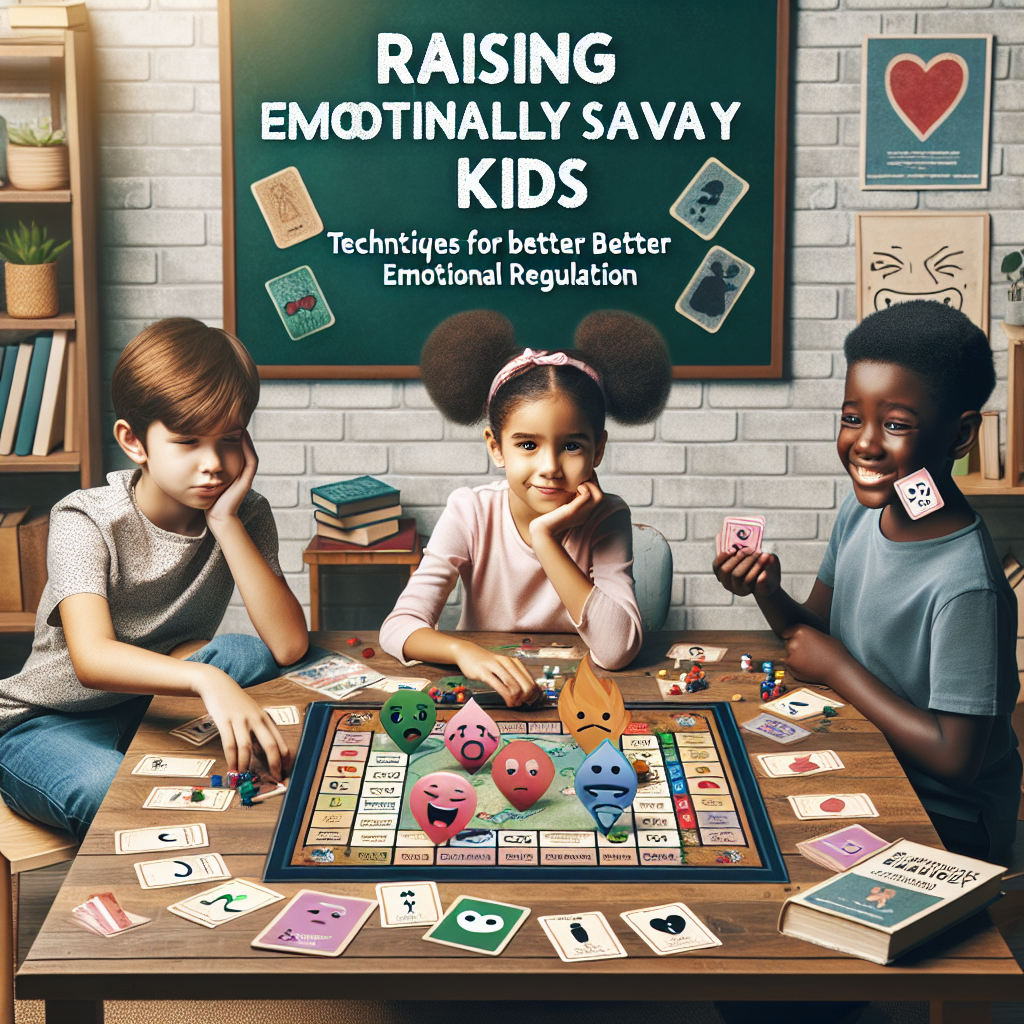
Raising Emotionally Savvy Kids: Proven Techniques for Better Emotional Regulation
Introduction
In our fast-paced, ever-changing world, emotional intelligence has emerged as a vital life skill for both adults and children. The ability to understand and manage emotions can significantly influence one’s success and happiness throughout life. This is why raising emotionally savvy kids is more essential than ever. Parents, educators, and caregivers have the exciting opportunity—and responsibility—to equip the next generation with the skills to navigate both their emotions and the emotions of those around them effectively.
In this article, you will discover proven techniques for better emotional regulation tailored specifically for children. From practical strategies to insightful real-world case studies, we will explore how emotional savvy can be cultivated in young minds. By embracing these techniques, you will not only empower your children to face life’s ups and downs with resilience but also enhance their overall well-being.
Understanding Emotional Intelligence
Before we delve into techniques, let’s clarify what emotional intelligence (EQ) is. Coined by psychologists Peter Salovey and John D. Mayer, EQ encompasses the ability to recognize, understand, manage, and reason with emotions. It consists of five key components:
- Self-awareness: Recognizing your own emotions and their effects.
- Self-regulation: Managing disruptive emotions and impulses.
- Motivation: Harnessing emotions to pursue goals.
- Empathy: Understanding the emotions of others.
- Social skills: Building and maintaining healthy relationships.
By focusing on these components, you can create a nurturing environment for raising emotionally savvy kids.
The Importance of Emotional Regulation
Emotional regulation is crucial for children as it influences their behavior, mental health, and relationships. Children who are adept at regulating their emotions can:
- Handle stress better.
- Develop healthier relationships.
- Experience fewer behavioral issues.
- Enhance academic performance.
- Cultivate resilience.
To support you in this endeavor, let’s explore some effective techniques to foster emotional regulation in kids.
Proven Techniques for Better Emotional Regulation
1. Model Healthy Emotional Regulation
Children learn by observing. When you demonstrate emotional regulation—through deep breaths, positive self-talk, or discussing your feelings openly—you provide your children with a living example of how to handle emotions.
Case Study: Consider Sarah, a single mom who found herself frequently overwhelmed at work. Instead of hiding her stress, she started practicing mindfulness. By sharing these moments with her 10-year-old son, they began to have open conversations about stress and coping mechanisms. This transparency inspired him to discuss his emotions more openly, leading to better emotional regulation on his part.
2. Encourage Open Communication
Create a safe space for your children to express their feelings without fear of judgment. Open dialogue about emotions fosters emotional intelligence. Use phrases like, "It’s okay to feel sad," or "Can you tell me more about that?"
| Table 1: Communication Techniques | Technique | Description |
|---|---|---|
| Reflective Listening | Listen attentively and reflect back what they say. | |
| Emotion Check-ins | Regularly ask how they are feeling. | |
| Open-Ended Questions | Encourage exploration of their feelings, e.g., "What made you feel that way?" |
3. Use Emotion Cards
Emotion cards are visual aids that can help children identify and label their emotions. By using colorful, expressive images of different emotions, you assist your child in recognizing what they feel.
Case Study: The Thompson family introduced emotion cards during dinner time, enabling each member to share one emotion they felt throughout the day. This practice not only nourished emotional expression but also strengthened family bonding.
4. Teach Deep Breathing Techniques
Deep breathing is a powerful tool for emotional regulation. Teaching your children simple breathing techniques such as the "5-5-5 method" (inhale for 5 seconds, hold for 5 seconds, exhale for 5 seconds) can help them calm down in moments of heightened emotion.
Tip: Make this exercise fun by incorporating a visual element, such as blowing up a balloon to represent their breath.
5. Set Up Emotional Regulation Playdates
Use playdates as a productive environment for emotional learning. Encourage games that require teamwork and emotional expression, such as role-playing or storytelling.
Analysis: During a playdate, when kids face conflict over a game, it presents an excellent opportunity to practice negotiation and using "I" statements to express feelings, fostering a deeper understanding of emotional interactions.
6. Implement Emotional Regulation Strategies in Daily Routines
Integrate emotional regulation strategies into everyday activities. For example, include emotion check-ins during car rides or family meals, allowing time for each child to share how they feel.
| Chart 1: Daily Emotional Check-in Schedule | Day | Activity |
|---|---|---|
| Monday | Morning Emotion Check-in | |
| Wednesday | Afternoon Share Circle Campfire Style | |
| Friday | Weekend Reflection Before Bed |
7. Use Stories and Books
Stories can be a fantastic gateway to discussing emotions. Read age-appropriate books that include characters experiencing different feelings. Discuss what the characters might be feeling and how they handle those emotions.
Case Study: After reading “The Color Monster” by Anna Llenas, a teacher implemented discussions that allowed children to identify their own ‘colors’ representing emotions, fostering a class culture of emotional awareness.
8. Create a Family Emotion Journal
Encourage your children to maintain an emotion journal to document their daily feelings and reflections. This activity promotes self-awareness and self-expression.
Tip: Include prompts like, "What made me smile today?" or "What was challenging, and how did I handle it?"
9. Teach Problem-Solving Skills
Help children learn how to approach problems logically and calmly. Providing them with strategies to resolve conflicts or issues can mitigate emotional distress.
Analysis: When faced with a problem, guide your child through brainstorming solutions and weighing the pros and cons of each approach, promoting emotional regulation through informed choices.
10. Encourage Physical Activity
Physical activity is essential for emotional regulation. Encourage participation in sports or physical activities to allow children a healthy outlet for pent-up feelings.
Case Study: When the Garcia family noticed their daughter became irritable during homework sessions, they introduced a 15-minute dance party to break the tension. This not only lifted her mood but also improved her focus when returning to work.
11. Celebrate Emotional Achievements
Acknowledge and celebrate emotional achievements, no matter how small. Recognizing a child’s efforts to manage emotions reinforces positive behavior.
Example: If your child successfully navigates a conflict with a friend without losing control, take a moment to highlight their achievement and discuss what worked.
Conclusion
Raising emotionally savvy kids through better emotional regulation is not just about teaching children how to manage their emotions; it’s a holistic approach that encompasses modeling behaviors, fostering communication, and creating healthy outlets for expression. By implementing the techniques outlined in this article, you are setting your children up for a future of emotional resilience, fulfilling relationships, and overall well-being.
Remember, nurturing emotional intelligence is a continuous journey, and every small step counts. Equip your children with the tools they need to thrive emotionally, and watch them grow into compassionate, emotionally savvy adults.
FAQs Section
1. At what age should I start teaching my child about emotions?
Children can begin learning about emotions as early as three years old. Introducing simple emotion concepts and vocabulary early on can set a solid foundation for emotional intelligence.
2. How can I help my child if they struggle with expressing emotions?
Engage them with emotion cards, storytelling, or expressive play. Encouraging open dialogues about feelings can also help them find ways to articulate their emotions.
3. What should I do if my child frequently exhibits extreme emotions?
Understanding the triggers and providing coping mechanisms is essential. Ensure consistent routines, reinforce communication, and consult a professional if needed.
4. How can I involve teachers in my child’s emotional development?
Encourage communication between you and your child’s teachers about emotional goals and progression. Work together to implement consistent strategies and approaches.
5. Are there any resources or books you recommend for parents wanting to teach emotional intelligence?
Books such as “The Whole-Brain Child” by Daniel J. Siegel and Tina Payne Bryson, and “How to Talk So Kids Will Listen & Listen So Kids Will Talk” by Adele Faber and Elaine Mazlish can be excellent resources for parents.
By applying the proven techniques for better emotional regulation shared in this article, you will undoubtedly enhance your child’s emotional intelligence and resilience, naturally leading to a more emotionally savvy generation.
















